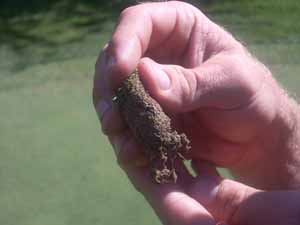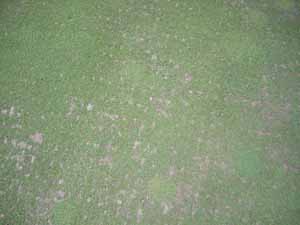 |
 |
A shallow root system in putting green bentgrass, this plant may not tolerate deep cultivation very well |
Surface following solid-tine cultivation procedure, notice the rootzone mixture on the surface, the point, be careful and be gentle! |
A Late-Summer Cultivation Checklist: Considerations for Success:
-
What you are trying to accomplish with this practice?
-
Organic matter/thatch removal?
-
Compaction relief?
-
Water/gas exchange?
-
Multiple things…
-
-
Is the turf healthy enough to cultivate as aggressively as you might intend?
-
How is the turf density, what is the condition of the root system? Will this procedure be too aggressive, will the machinery cause pulling, tearing and serious surface disruption (don’t forget about tire tracks…)?
-
-
Is the turf healthy enough to rapidly recover from the procedure?
-
Is the turf vigorous and actively growing? When did you last fertilize, how much and what product (will it last)? Make sure the turf is hydrated prior to initiating cultivation. If the turf is malnourished and growing slowly due to drought and heat stress, post cultivation fertilization may take some time to actually “kick-in”, delaying recovery, as opposed to appropriate balanced fertilization prior to cultivation.
-
Are areas of localized dry spot present? If so, these will likely recover more slowly and must be corrected prior to cultivation.
-
-
Evaluate the prevailing and future environmental conditions:
-
Is the five to seven day weather forecast favorable for vigorous turf growth? What are the predictions for the night-time temperatures?
-
What about the soil temperatures? Generally, cultivation is thought to stimulate root growth. For cool-season turfgrasses, however, if the soil temperatures are > 77 F, no new root initiation is likely occurring. If enhanced root growth is the primary goal, perhaps cultivation later in the fall may be a more appropriate timing.
-
-
Timing: Plain and simple, cultivation is mechanically abrasive, the turf should be well hydrated and not under heat stress. Ideally any cultivation should be conducted in the early morning. If the weather forecast indicates extremely hot conditions later in the day some golf course managers are conducting the cultivation procedure at night. Now this is clearly not ideal in terms of scheduling but this may limit turf stress during the procedure and subsequent clean-up.
-
Topdressing: To topdress or not to topdress, that is the question… Think turf health first!!! Topdressing is applied to smooth the surface and dilute organic matter. Many managers that experienced a decline in shoot density due to the extremely stressful weather this past summer may be tempted to apply higher rates of sand topdressing for the purpose of filling in voids and smoothing their putting green surfaces. Realize this practice may be a double-edged sword at this time of year. Certainly adding a layer of topdressing may aid in smoothing the surface but sand topdressing also generates heat and when moved around can be mechanically abrasive to succulent leaves. This in turn may result in additional turf stress and perhaps the onset of what may appear to be disease or disease like symptoms (e.g. the topic du jour for 2010, do I have bacterial wilt???). Hence, in addition to making sure your turf is healthy enough for cultivation and recovery from a fertility standpoint, another consideration may be, when did you last apply your plant protectants, will they last during recovery?
If you must topdress consider your application rate, temperature and humidity and any incorporation techniques VERY carefully. Perhaps a lighter rate, applied more frequently or avoiding dragging the topdressing or alternative techniques like using a back-pack blower is in order? Also remember, dry sand applied to dry surfaces will incorporate much more easily than wet or moist sand.
The take home message: Cultivation at all times of the year is an extremely important cultural practice for the persistence of all closely mowed turf areas. Don’t shoot yourself in the foot and make already weak turf even weaker. Don’t be afraid to deviate from your traditional cultural plans if it appears that it may be in the best agronomic interest of your existing turf. Remember what you do right now will have immediate effects but also don’t neglect the potential long-lasting effects for 2011 too.